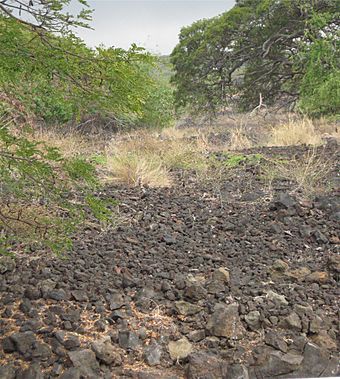Keauhou Holua Slide facts for kids
|
Keauhou Holua Slide
|
|
 |
|
| Lua error in Module:Location_map at line 420: attempt to index field 'wikibase' (a nil value). | |
| Location | Aliʻi Highway, Keauhou, Hawaii |
|---|---|
| NRHP reference No. | 66000290 |
Quick facts for kids Significant dates |
|
| Added to NRHP | October 15, 1966 |
| Designated NHL | December 29, 1962 |
The Keauhou Hōlua Slide, also known as Kāneaka Hōlua Slide, is a very old and important place in Keauhou on the island of Hawaiʻi. It is the largest remaining hōlua course in the Hawaiian Islands. This special slide was used for a thrilling and risky sport called heʻehōlua, or Hawaiian lava sledding.
For a long time, many people thought only the aliʻi (royal chiefs and nobles) could do this sport. But old stories show that both male and female nobles in ancient Hawaii took part. In fact, heʻehōlua was widely played by many Kanaka Maoli (Native Hawaiian) people across the entire paeʻāina (Kingdom of Hawaii).
This particular kahua hōlua (hōlua slide) was often used for special ceremonies. However, it might have been used for fun at other times too. Some burials have been found near the slide. This suggests that injuries and even deaths sometimes happened during this challenging sport.
Contents
The Keauhou Hōlua Slide: An Ancient Hawaiian Sport
The Keauhou Hōlua Slide is about 2,600 feet (790 m) long today. It used to be much longer, over 5,280 feet (1,600 m)! The slide originally reached all the way to the shoreline at Heʻeia Bay. You can still see small parts of the slide near the ocean where the waves meet the rocks.
Building a Hōlua Slide
Building a kahua hōlua like this was a big job. First, large flat pieces of pāhoehoe lava rock were laid down. Then, smaller and smaller lava pieces were added on top. Finally, the surface was covered with fine ash. When the slide was used, it was lightly covered with pili grass, which is native to the islands. This grass helped reduce friction between the papahōlua (sled) and the lava surface.
Who Used the Hōlua Slide?
The Keauhou Hōlua Slide was important to royal families. Kings like Kamehameha III and David Kalākaua used this area. The slide was also connected to the Makahiki games. These games were like the ancient Olympics for Hawaiians.
The Keauhou Slide Today
You can see parts of the slide from Aliʻi Highway, right across from the Kona Country Club golf course. The part of the slide below the road was changed a long time ago. Now, a golf course and vacation homes are built there. The preserved parts of the slide above the road are best seen from above, like from an airplane. You can find its exact location using these coordinates: 19°33′44.43″N 155°57′30.5″W / 19.5623417°N 155.958472°W.
Today, there is one modern kahua hōlua slide built in 2011 at Turtle Bay Resort in Kahuku, Oʻahu. People also practice heʻehōlua on grassy hills and pastures on the islands of Hawaiʻi and Maui.
A National Historic Landmark
By the 1950s, trees and bushes were growing over the sides of the slide. Some parts had also sunk because of earthquakes. To protect this important site, it was added to the list of National Historic Landmarks in Hawaii on December 29, 1962. It was also added to the National Register of Historic Places listings on the island of Hawaii on October 15, 1966.
You can learn more about the Keauhou Hōlua Slide and other historic sites nearby. A small museum at the Keauhou Shopping Center has a copy of a hōlua sled and more information.
Images for kids


